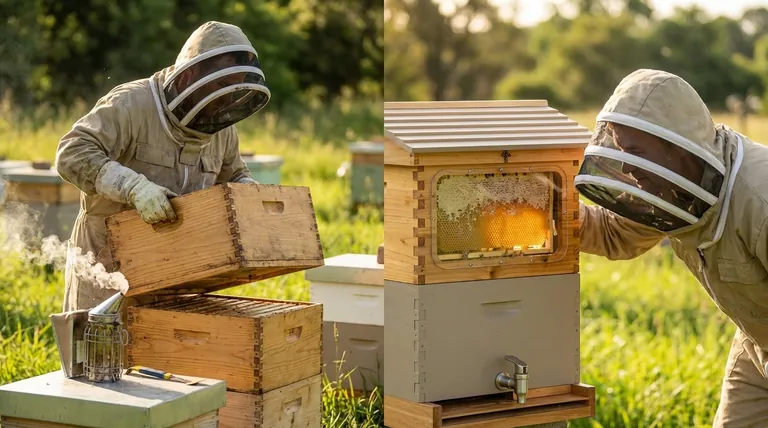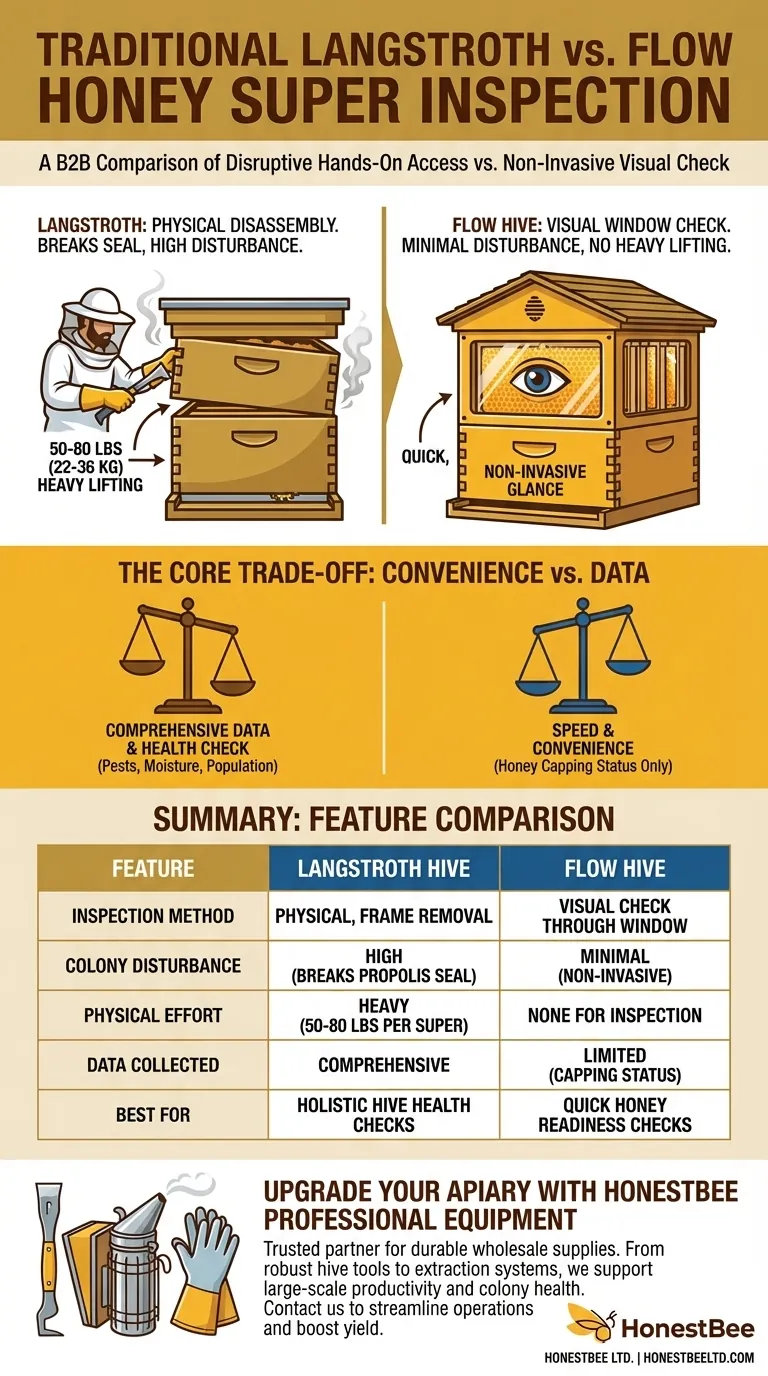At a glance, the difference is clear. Checking a traditional Langstroth honey super requires physically disassembling the hive, while inspecting a Flow Hive super is a non-invasive process done by looking through a window. The Langstroth method involves breaking the hive’s seal and lifting a heavy box, whereas the Flow Hive is designed for a quick visual assessment from the outside.
The core distinction is not just about physical effort; it’s a fundamental trade-off between the comprehensive, hands-on data you get from a disruptive inspection versus the speed and convenience of a limited, non-disruptive visual check.

The Traditional Langstroth Inspection: A Necessary Disruption
Inspecting a standard Langstroth super is an integral part of a full hive health check. It is a physical, hands-on process that intentionally prioritizes complete access over minimal disturbance.
Breaking the Hive Seal
Bees use a substance called propolis to glue all hive components together, creating a weather-tight and sterile environment. Opening the hive means you must use a hive tool to pry the super loose, breaking this seal.
Managing the Colony
This process is disruptive to the bees. It typically requires using a smoker to calm the colony and encourages them to move down, away from the area you need to access.
The Physical Demand
A standard Langstroth super full of honey can weigh between 50 and 80 pounds (22-36 kg). Safely lifting and removing this weight is a significant physical consideration for the beekeeper.
The Benefit of Full Access
While disruptive, this method gives you complete access. You can pull out individual frames to check for pest presence (like Small Hive Beetle), assess the honey's moisture content, and see the bee population density within the super itself.
The Flow Hive Inspection: A Window of Convenience
The Flow Hive super is engineered specifically to reduce the disruption and labor associated with honey checks. Its design separates the act of checking honey readiness from a full hive inspection.
The Viewing Window Advantage
The most significant feature is the end-frame viewing window. This allows a beekeeper to see if the bees have filled and capped the outermost cells with honey at a simple glance.
Minimal Colony Disturbance
Because you don't need to open the hive, the bees are not disturbed. You don’t need to break the propolis seal or use a smoker, which dramatically reduces stress on the colony for this specific task.
No Heavy Lifting Required
The inspection is purely visual. The heavy lifting is deferred until the separate and less frequent task of a full brood box inspection.
Understanding the Trade-offs: Convenience vs. Data
Neither method is inherently superior; they simply optimize for different goals. Understanding their limitations is critical to responsible hive management.
What the Window Doesn't Show
The Flow Hive window provides one key data point: whether the visible cells are capped. It cannot show you the status of the inner frames or reveal pests that may be hiding between frames.
Holistic Health vs. Honey Status
A Langstroth inspection, by its nature, encourages a more holistic check of the colony's condition within that super. A Flow Hive inspection intentionally decouples the "is honey ready?" question from a deeper hive health assessment.
The Risk of Complacency
The primary risk of the Flow Hive's convenience is that it can lead a beekeeper to neglect the more critical inspections of the brood boxes below. A quick, easy honey check does not replace the need for regular, thorough examinations of the entire colony's health.
Making the Right Choice for Your Goal
Your beekeeping philosophy and physical capabilities should guide which approach you favor.
- If your primary focus is minimizing physical strain and colony disruption for honey checks: The Flow Hive's viewing system is purpose-built for this goal.
- If your primary focus is integrating honey checks with comprehensive hive assessments: The traditional Langstroth method ensures you have full access to the hive's components.
- If you are a new beekeeper prioritizing hands-on learning: The tactile feedback and complete access of a Langstroth inspection offer a more thorough, albeit challenging, educational experience.
Ultimately, the best inspection method is the one that helps you remain a consistent and attentive steward of your colony's health.
Summary Table:
| Feature | Langstroth Hive | Flow Hive |
|---|---|---|
| Inspection Method | Physical, hands-on frame removal | Visual check through viewing window |
| Colony Disturbance | High (breaks propolis seal) | Minimal (non-invasive) |
| Physical Effort | Heavy (50-80 lbs per super) | None for inspection |
| Data Collected | Comprehensive (pests, moisture, population) | Limited (honey capping status only) |
| Best For | Holistic hive health checks | Quick honey readiness checks |
Upgrade Your Apiary with Efficient, Professional Beekeeping Equipment
Whether you manage a traditional Langstroth operation or are exploring modern systems like the Flow Hive, having the right supplies is crucial for productivity and colony health. HONESTBEE is your trusted partner, supplying durable beekeeping supplies and equipment to commercial apiaries and distributors through our wholesale-focused operations.
We provide everything from robust hive tools and smokers to protective gear and honey extraction systems, designed to meet the demands of large-scale beekeeping. Let us help you streamline your inspections, improve hive management, and boost your honey yield.
Ready to enhance your beekeeping efficiency? Contact our expert team today to discuss your wholesale needs and discover how HONESTBEE can support your business growth.
Visual Guide

Related Products
- Langstroth Honey Bee Box Hive Boxes for Different Depths
- Langstroth Bee Hives Bee Keeping Box for Beginners Beekeeping
- Australian Langstroth Beehive Boxes for Beekeeping Wholesales
- 5 Frame Langstroth Poly Nuc Corrugated Plastic Nuc Boxes
- Professional Insulated Plastic Bee Hives
People Also Ask
- What is the best time to inspect a hive? Optimize for Bee and Beekeeper Safety
- Why do you need two bee hives? Boost Your Apiary's Success with Smart Risk Management
- How should hive boxes be aligned after reassembly? Ensure a Perfect Seal for Hive Health
- How does a hive box work? A Guide to the Langstroth Hive System for Beekeepers
- What factors should beekeepers consider when choosing between wooden and polystyrene hives? Maximize Bee Health and Honey Production



















